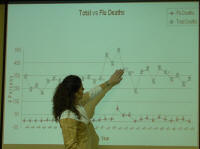|
The current focus is on flu, but the work being prepared covers a
number of other potential biohazard situations as well. What's
the difference between the flu that comes around every year and one
that might cause an epidemic?
Seasonal flu:
-
Symptoms: fever,
cough, runny nose, muscle pain
-
Affects 10 percent of
the population
-
Most susceptible:
elderly, very young and individuals with compromised health
-
Prevention and
treatment available
-
Deaths often caused
by complications, such as pneumonia
-
Low mortality rate:
36,000 deaths per year
Pandemic or epidemic flu:
-
Requires an unknown
flu strain that spreads easily
-
Occurs rarely
(Spanish flu, 1918; Asian flu, 1957; Hong Kong flu, 1968)
-
More severe symptoms
-
Could affect 25
percent to over 30 percent of the population
-
Risk to all ages
-
A period of time for
viral medications or vaccine to be developed and mass production
to meet population need
-
High mortality rate
(The CDC lists the U.S. 1918 flu death toll at 675,000. The
world population in 1918 was 1 billion. The world population in
2006 is 6 billion.)

According to a biosecurity report by the Saint Louis University
School of Public Health, a severe outbreak of disease without
control measures could cause:
-
90 million people to
become sick.
-
30 percent infected.
-
Social disruption.
-
Absenteeism could
reach 40 percent.
-
An economic impact
between $160 billion to $800 billion.
The flu epidemic of 1918 was the worst seen in the 20th century.
It shut down businesses; food and medical help were in short supply;
and there were numerous other ramifications.
In Lincoln, every school, theater and public place was ordered
closed for 11 days in December. Adults and children were discouraged
from going out in the streets during the Christmas and New Year
holidays that year.
[to top of second column]
 |
 Logan County Health Department research of death certificates in
the county revealed that an estimated 18 percent of the deaths that
year, 97 of approximately 550, were attributed to the flu.

Molly Jo
Ehlert of the Logan County Health Department presents new findings taken from Logan County death
certificates from 1902 to 1930. The chart shows all deaths on the
upper line and flu deaths on the lower line.
This information has
added to previous numbers from 1930 to today.
Could that happen again, nearly 200 years later?
Even in this modern age of technology, it might take six months
to identify new strain of flu and develop a vaccine against it.
Public health officials recognize that a communicable disease could
spread rapidly and sicken or even kill 25 percent of the population.
An epidemic could occur, and it would affect daily life even here in
the U.S.
Worldwide communications, improved medical care and technologies
give us a better means of controlling the spread of flu.
What can you do to protect yourself and your family?
At the personal level, people are encouraged to stop the spread
of germs and use good hygiene.
It is also advisable to create your own all-purpose emergency kit
that would take care of family needs several days or even weeks. It
should include water and nonperishable food, such as canned goods;
medications and prescriptions; and don't forget food for Fido and
kitty. [See
more
details of what to include in your home kit (second page of the
PDF file).]
[To download Adobe Acrobat Reader for the PDF
file, click here.]

While it impossible to predict just what might happen, local
leaders are now sorting through the next set of decisions that they
may face, in hopes of being more prepared. Steve Siltman, director
of the Logan County Paramedic Association, suggested that the
unanswered questions be addressed by subcommittees of those who
would be most involved in those areas.
LDN will continue to bring you more information on this important
subject. In the meantime, follow Mom's advice: Cover your mouth when
you cough or sneeze, and wash your hands.
[Jan
Youngquist]
[Part
1, posted Oct. 6] |